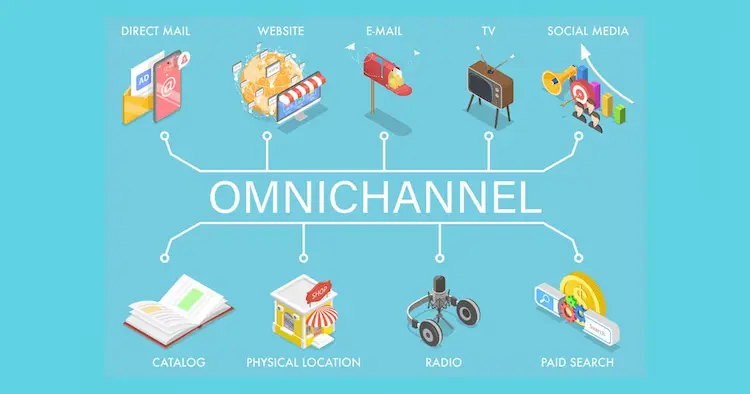The retail industry has undergone a significant transformation over the past decade, and omnichannel strategies have played a crucial role in this evolution. More is needed for retailers to rely solely on traditional brick-and-mortar stores or e-commerce websites. As customers expect seamless and convenient shopping experiences, businesses must integrate offline and online channels.
This article explores the benefits of adopting an omnichannel approach and offers practical tips for businesses to harmonize their online and offline presence.

What is Omnichannel Retail?
Omnichannel retail integrates various shopping channels, such as physical stores, e-commerce platforms, social media, and mobile applications. This approach enables customers to interact with a brand through a unified and consistent experience, regardless of their chosen channel. From browsing products to purchasing, omnichannel retail ensures customers enjoy a smooth shopping journey.
Benefits of Embracing Omnichannel Strategies
- Improved Customer Experience: By offering a consistent and personalized shopping experience across multiple channels, retailers can better meet customers’ needs and preferences. This, in turn, can boost customer satisfaction and foster brand loyalty.
- Increased Sales: Integrating different channels can increase the likelihood that customers will purchase. For instance, a customer may discover a product through a social media advertisement and purchase it in-store or online. Omnichannel retail enables businesses to capture such sales opportunities and boost their revenue.
- Enhanced Data Collection and Analysis: Tracking customer behaviors and preferences across various channels can give retailers valuable insights. These data points can be leveraged to optimize marketing campaigns, personalize offers, and improve the shopping experience.
- Greater Operational Efficiency: With a comprehensive view of inventory levels, businesses can more effectively manage their stock across channels, reduce the risk of overstocking or stockouts, and ultimately enhance customer satisfaction. One way to improve operational efficiency is by adopting shelf-ready packaging, simplifying product distribution and placement in physical stores, and making the supply chain more streamlined.
Ensure Brand Consistency
To create a seamless customer experience, businesses must maintain a consistent brand identity across all channels. This means aligning the visual and messaging elements such as logo, color scheme, and tone of voice. A uniform brand presence not only enhances professionalism but also makes it easier for customers to recognize and trust your brand.

Click-and-Collect Services
Click-and-collect services offer customers the convenience of purchasing products online and picking them up at a physical store. This not only drives foot traffic to the store but also caters to customers who prefer flexibility when shopping.
Invest in User-Friendly Design
Whether customers interact with your brand through a website, mobile app, or physical store, investing in user-friendly design is essential. Ensuring easy navigation, responsive web design, and clear calls to action can improve the overall shopping experience and increase conversion rates.
Leverage Social Media
Social media platforms are powerful tools for connecting with your audience and boosting online visibility. By creating engaging content, promoting products, and providing timely customer support, retailers can capitalize on the vast reach of social media and foster brand loyalty.

Monitoring and Continuous Improvement
Ongoing monitoring and analysis of your omnichannel strategy are essential for continuous improvement. Identifying and resolving pain points, as well as embracing customer feedback, aid in refining the customer experience. It’s crucial to stay informed of advancements in retail technology and industry trends to remain competitive in today’s ever-evolving retail landscape.
Optimize Inventory Management
Employing inventory management software that syncs inventory levels across multiple channels can help businesses optimize stock levels and reduce operational costs. Moreover, offering customers real-time access to product availability online and in-store can further enhance the shopping experience.
Related Post: 4 Inventory Management Tips for Small Businesses
Creating Seamless Customer Support
Providing exceptional customer support across all channels is imperative for an effective omnichannel strategy. Ensuring customers can easily access support through their preferred method, email, phone, live chat, or social media, can significantly enhance customer satisfaction.
Additionally, training customer service representatives to assist customers consistently across channels reinforces a seamless experience and fosters brand loyalty.
Incorporating Emerging Technologies
Embracing emerging technologies such as augmented reality (AR) and artificial intelligence (AI) can further elevate the omnichannel retail experience. For example, AR can provide customers with an interactive and immersive experience, allowing them to virtually try on products before purchasing. Similarly, AI-powered chatbots can offer personalized product recommendations and instant customer support, creating an unmatched shopping experience.

Also Read: The Many Benefits of AI Integration in eCommerce
Conclusion on Omnichannel Strategies in Retail
In today’s competitive retail landscape, adopting an omnichannel strategy is now optional but necessary. By integrating offline and online channels, retailers can deliver an unmatched customer experience that boosts sales, increases brand loyalty, and drives long-term success.
By following the practical tips outlined in this article, businesses can navigate the complex world of omnichannel retail and revolutionize their approach to customer engagement.